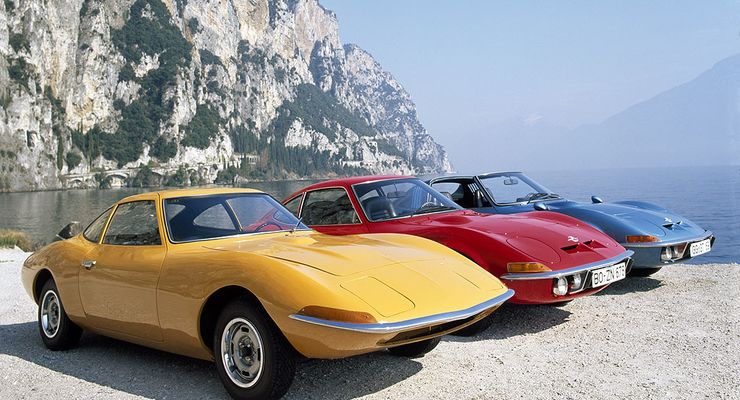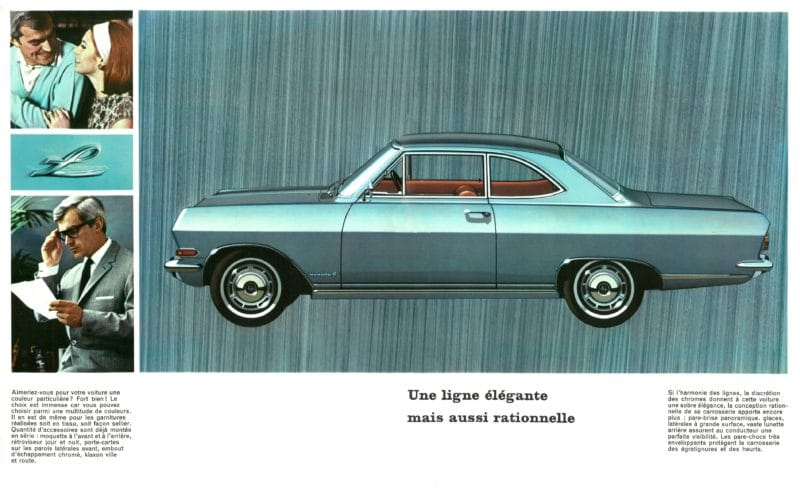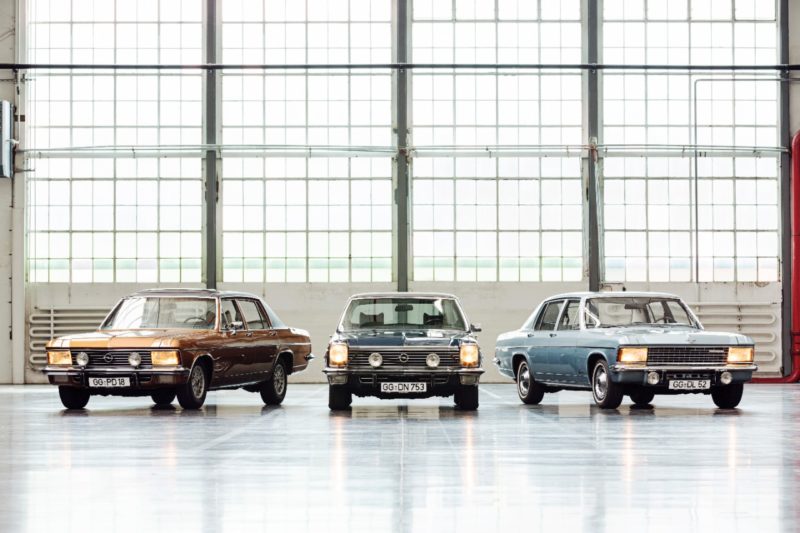Olympia, Olympia-Rekord, Kapitan, Blitz. In the 50s, the range of the American-German manufacturer Opel was solid, affordable, voluminous and ... bourgeois. “Opel, that Zuverlässige.” The reliable. The word "sporty" was not in the vocabulary. Beautiful coupes and roaring exhausts was something for loose-minded Italians or eccentric British. But that would soon change.

In the 60s, the solid, but somewhat soulless Opel emerged as “a pike in the carp pond”, as one motoring journalist wrote. It started with “the raging trunk” and ended with the GT and the Bitter CD. An article about the most attractive Opels of the Swinging Sixties!
Opel Rekord P2 Coupe
In 1961, at the International Motor Show in Frankfurt am Main, two sporty Opels stood on a huge turntable: the introduction of the Rekord P2 Coupé. It was of course based on the two-door sedan of 1960, of which a 2 + 2 was made, so that the ratio of roofline and trunk was a bit out of balance. The car had such a long stern that it was nicknamed “Der rasende Kofferraum” in its own country. Less car for more money, but the model still appealed to many people.
This most expensive Rekord came only with the most powerful engine, the time-honored Olympia 1700 OHV, which produced 67 horsepower and was mated to a four-speed gearbox with steering wheel controls. A gear lever was not available, but an automatic Olymat clutch was. Furthermore, this car still completely breathed the atmosphere of that time. The time of quiffs, pointed shoes and narrow trouser legs. Cliff Richard sounded from the mono radio: C'mon pretty baby, let's a move it and a groove it! And so Opel plunged into the colorful sixties.
Opel Kadett A Coupe
In 1962 Opel introduced its "Beetle-killer" on the market, a year later the very sympathetic coupé version followed. This was only available in the "L" version, so with two-tone upholstery, on request also with duo-tone paint, tires with white side surfaces, a clock and here and there a piece of extra chrome.
In 1964, a year before the introduction of the B-Kadett, the A-Kadett could already be delivered with the bored-out 1100S engine, which turned the 55 kilo light Kompeltje into a pleasantly smooth coupe with 680 horses. With the long poker, yes.
Opel Rekord A Coupe
In 1962 the iron had been passed over the Rekord series. The newest member was slightly longer and wider and stripped of all the jukebox-like beauty that still adorned the P2. And special in its class were the curved side windows. Under the hood was the very last version of the Olympia engine from 1935, with its crankshaft bearing four times and OHV construction, already an old 1500 or 1700 cc beast.
Opel engineers also managed to fit the 2600cc Kapitän engine in the front, with an inch of clearance at the front and rear and the radiator on the side. This was also an old engine, it came from the Opel Supersix of 1937 and had grown to a juicy 100 hp in all those years. That gave the Rekord Six a top speed of 170 km/h, impressive in those years. It was also an extraordinarily elastic engine, delivering its maximum torque as early as 1500rpm, just above idle. With this engine you could also start in second or third gear, it didn't budge. But it was not sporty and the heavy cast iron block did not make the steering any lighter. That is why very few have been sold.
Opel Rekord B Coupe Six
In 1965 the Rekord got a slightly different look, with rectangular headlamps and round taillights that would later be used for the Manta and GT. The B-Rekord was the first Opel to have a 12V installation. Disc brakes were also installed and the track width of the rear axle was increased. The biggest news was of course the new engine line.
"Camshaft-In-Head" was a construction in which the camshaft still operated the valves with push rods and rocker arms, but that camshaft was on the side in the head instead of in the block, the push rods were only five centimeters long and the rocker arms were (GM patent) made of pressed sheet steel. Advantages: the valve mechanism was as light as a feather, the height of the head remained limited, the valve sets were a chore and the engine tolerated high revs just as easily as a copy with an overhead camshaft. Hydraulic valve lifters were even possible, which made adjusting the valve clearance completely unnecessary. It was a strange construction, but the CIH block would prove itself millions of times over the next thirty years as a proverbial reliable engine. The disadvantage of this engine was that no cross-flow head was possible. That limited the power and the fuel economy. But it was solid, and easy to maintain. And that's what the customers asked.
In the Rekord, the four-cylinder versions were available with 1500, 1700 and 1900 cc. The six-cylinder remained unchanged, the antique Kapitän-2600 engine of 100 hp. But that wouldn't last long.
Opel Kadett B Coupe
In 1965 Opel dealt the deadly blow to Volkswagen with the B-Kadett. Technically, this scion looked exactly like its older sister, but the car grew both in length and width and became a five-seater. The standard engine became the 1100N of 45 hp (although the 1000S remained available in countries such as France and Italy where an engine below 1000cc was a tax advantage).
The very beautiful coupé (the 'Kieuwen-coupé') was available from day one in the L-version and with the 55 hp 1100S engine. The 1900S engine with 90 hp could also be ordered. In 1966 a version of this coupé appeared with bucket seats, extra gauges, a sports steering wheel, sports rims, black accents and a red and black Rally-Kadett lettering on both the boot lid and the glove box. Under the hood, the well-behaved Kadett engine was made a lot more lively with increased compression, two Solex 35mm downdraft carburettors and a twin exhaust manifold. This 1100SR engine delivered 60 hp at the crankshaft, good for fierce acceleration and a top speed of 140 km/h.
From 1967, the Rally-Kadett could also be supplied with the 90 hp 1900S engine with which the 165 km/h could be tapped and fortunately a year later the wheel suspension was adapted to such speeds: the rear axle finally got coil springs, a stabilizer bar and the five-point suspension that significantly improved the notorious crosswind sensitivity.
In 1970, the Rally-Kadett in the version as a Gill coupé would be discontinued, a Manta was now available. The regular Kadett coupé could be equipped with the stronger 1971S engine from 1200.
Opel Ascona 1700
For the Swiss and Austrian markets, the Swiss General Motors plant in Biel built a 1700S variant of the Kadett, which was somewhat better suited for the Alps. They could be recognized by a chrome strip on the sides and the nameplate “Ascona”. It was not the first Opel Ascona, the luxurious Swiss version of the Olympia-Rekord P1 from 1957 was also called that.
Opel Rekord C Coupe
In 1966 Opel tried to beat arch-rival Ford with the brand new Rekord C. Ford had overtaken Opel in the middle class at that time with the Taunus 17m P5, but had to give up that position a year later thanks to the larger Opel Rekord C. ? The C-Rekord would be the largest in its range, measuring an impressive 4,55 meters in length and offering plenty of interior space. Visually it was a bold design, with feminine curves above the rear wheels, a style element that clearly came from Detroit and which Opel initially felt little for, given the many drawings in which these hips were painted away. But with 1,2 million copies, the C-Rekord would be an unparalleled success.
Even more beautiful than the coach and sedan was the hardtop coupe. The top model was again a six-cylinder, this time the CIH 2200S engine that had the same bore and stroke as the modest 1500S. It was therefore a typical long-stroke engine, so not a touring machine and more of a cruiser than a sprinter. For the fiercer work, the 1900S could of course be ordered, which was even cheaper. This was also apparent from the sales figures: the Rekord Six 2200S sold poorly and was removed from the program in 1968.
Opel Diplomat Coupe
I previously devoted an article to this car. A real Gran Turismo from Rüsselsheim with a top speed of 210 km/h and an executioner of 5400cc under the long hood. An Opel that dared to nibble on the Mercedes-Benz customer base. The Diplomat Coupé was the ultimate luxury and fast version of the Diplomat V8. Thanks to a lot of tug-of-war with the boss in Detroit, it was equipped with the engine from the Chevrolet Corvette, mated to a two-stage Hydra-Matic. The car was not sporty, with its American road holding and steering behaviour, but it was comfortable in the superlative. The split rear seats, real wood, leather, tinted glass and hardtop styling finished it all off. In its short production time, two years, only 347 were sold. It was a flop for Opel. A loss-making project. Now it is an object on the more expensive car auctions, because under 100.000 euros you can no longer buy anything in running condition.
Opel Commodore A 2500GS/E Coupe
The Rekord Six faced competition in-house with the Commodore A. We write 1967 and Opel upgraded the solid Rekord series with the sporty and luxurious variant, the Commodore. So a completely new line, although the technology originated from the Rekord and KAD series. That technique consisted of the shrunk version of the new 2800cc six-cylinder Kapitänmotor, which was available in the Commodore as the 2500S with 115 hp, the 2500GS with 135 hp and the GS/E, which with its Bosch petrol injection delivered 145 hp and at the same time was more economical. .
The 2500 GS/E Coupé was a beauty with its hardtop line, beautiful finish, extra instruments under the dashboard and a top speed of 185 kilometers per hour. This made it one of the fastest European passenger cars, an Opel that could handle a Porsche.
Of course, the more expensive Commodore range differed from the Rekord with more chrome, larger rims, lots of imitation wood and a chrome trim panel between the taillights. On order, a 2500H engine could also be installed, which produced 145 hp. Not everyone blindly trusted the injection engines back then.

And in 1970 the 2800cc CIH engines became available. The 2800 GS/E Coupé blew aside everything that went slower than 200 km/h on the Autobahn. What an attractive car.
Opel Olympia Coupe and hatchback

In 1967, the Kadett got a chic sister, in the form of the Olympia A. Until the arrival of the Ascona, it would close the gap between Kadett and Rekord and was also intended to be able to sell a somewhat more luxurious, compact car in the US. . It was never made as a sedan, there was a Coupé and a hatchback, which in the Kadett version would be called LS.
The Olympia was more luxurious than sporty, but under the hood was the 1100SR 60 horsepower engine with its two Rally-Kadett carburettors. The 1500S, 1700S and 1900S could also be delivered, with which the Rekord 1500S expired. The car further justified its extra cost with a luxurious interior full of imitation wood, a short lever, carpet and chrome everywhere and a very complete equipment.
Opel Rekord Sprint Coupe
For those who wanted to pick the paving stones a bit cheaper, the Rekord Sprint was in the showroom from 1968. That was a brightly colored Rekord Coupé, equipped with extra lamps, extra instruments, bucket seats, sports rims and – very special – tires with red lines on the sidewalls. Under the hood was the tuned 1900HL engine that delivered 106 horsepower thanks to a higher compression. This Rekord ran 175 km/h and that was a nice ratio between price and performance in 1970, because an Opel still cost no BMW or Mercedes money.
Vauxhall GT 1900S
His prototype was ready in 1965, but buyers had to wait until 1968. Only in that year was the chassis of the B-Kadett suitable for equipping a sports car. This mini-Corvette would make you forget everything that characterized Opel in the 50s, it was all youthfulness and driving pleasure. “Nur flying is better!” The GT was not practical, the boot lid was missing and luggage had to find a place through the interior. Well-known was the cinema advertisement in which a customer in the showroom tries to squeeze himself into a GT, beer belly and all, which does not work. “Ah, we also have a suitable model for him,” says the voice-over.
The GT got the 1900S engine or a 1900H for an extra charge. There was also the version with the 60 hp 1100SR engine. The GT was built only briefly; with the arrival of the C-Kadett, he left the program after just five years. For a niche car that sold so short, it made a lasting impression.
Opel admiral
Finally the new KAD series. In Nice, on the sultry and chic Côte d'Azur, Opel presented the new top models in the spring of 1969. According to many, the KAD-A series was based too much on the Chevrolet Nova, too American, too big for European streets and squares. In addition, the handling was nothing to write home about. The KAD-B series made all that forget, the cars were slightly shrunk, but the interiors were bigger. And above all: they lay like a rock on the road thanks to coil springs all around and a DeDion rear axle. For the sporty businessman, Opel offered the Kapitän / Admiral / Diplomat 2800H: with two Zenith carburettors, this engine offered 145 hp, a top speed of 185 km/h and a black headliner. The fastest versions had injection: the 2800E delivered 175 hp and a top speed of 185 km/h.
Bitter CD
With the debacle of the 1966 Coupé-Diplomat in mind, Opel was hesitant about a new coupé version of the Diplomat B, which had already been prepared in Detroit by none other than GM chief designer Chuck Jordan. Fortunately for Chuck and the rest of the world, in 1971 this became the basis for the Bitter CD, a version finished by the Swiss importer using Frua, which would last for years to come.


























Yes Bart, nice article. And idk, give me a real Chevy!
The white P2 coupe with the dark blue roof and.. The open roof, one of the many records that my parents used to have.
I myself still have a b rekord from 1966. 4 doors and bought new over the year 196. Had a lot of fun with the 480000 km with an engine overhaul. Still in good riding condition.
Beautiful story Olav, nice overview. Opel understood the art of excellent and versatile car construction. Wonderful brand, especially in the past.
What does a lively car brand look like?
1960 Olympia-Rekord P2 . delivery starts
1961 Olympia-Rekord P2 Coupe starts
1962 starts Kadett A
1963 starts Rekord A and Kadett A coupé
1964 starts KAD-A series
1965 start Kadett B + coupe, start Rekord B
1966 starts Rekord C and the new six-cylinder engines in the KAD-A series, starts Rally-Kadett
1967 Olympia A and Commodore A . start
1968 starts GT and Rekord Sprint
1969 starts KAD-B series
1970 starts Ascona-A and Manta-A
And so it went on for many years, until after the last successful Omega series the cake was apparently finished. After that, I was more or less forced to drive a Volvo, until today.
It's a shame that a brand can become so meaningless.
Opel record. AK 71 80. A green one in my memory. My dad's second car.
My 1st car in 1981, my father's ´´old´´ B cadet, with ´I think´ a 1.100 engine, with LONG poker !!! … FULL GAS – Tailwind – Sun at your back – downhill 130KM per hour !!! … Since then, GM has remained loyal, only the USA versions, UNTIL today – 40 years later !!! … Because let's be honest ´´Nobody beats Cubic Inches´´ and if ´´the knacks´´´ still fall out of the exhaust, then there is no MORE BEAUTIFUL sound than a V8 that SLAPs !!! … However.
“Nothing can beat cubic inches” has cost the American auto industry its good name. After 1973, fuel prices skyrocketed here and a whirlpool in the tank was simply considered a waste. European manufacturers have been really committed to fuel economy ever since, and so did the state of California, but on the environmental front.
The result? Let's stick with Opel, the Diplomat Coupé of 1966 consumed 1:5. The equally fast Commodore 2800 GS/E from five years later consumed 1:7. And now? The equally fast and heavy Insignia 2.0 Biturbo consumes a neat 1:16. That has been achieved here in Europe and also in Japan, and still not on the other side of the big pond.
The very first Opel Ascona was a pimped Olympia-Rekord P1 and was specially developed for the somewhat richer Swiss market.
Nice time frame and nice pics!
Thank you!
It is sad how few new beautiful initiatives are now emerging from the hands of the current designers. It makes old-timer ownership even more attractive.
Opel, just like the competition, has become a dull and boring brand.